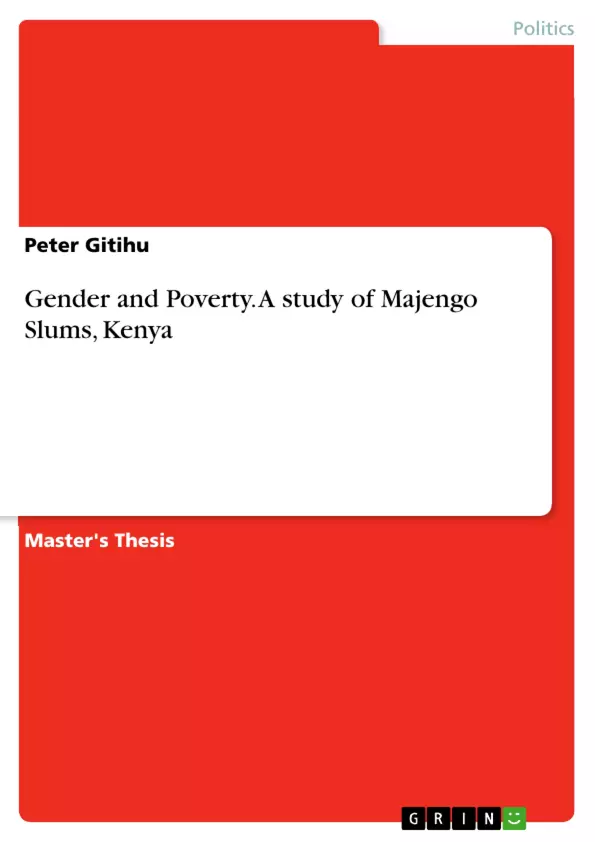The study aimed at investigating the relationship between gender and poverty. Poverty is a major obstacle to development in Kenya and in spite of efforts by the government and NGOs to fight it, it persists. Since poverty affects men and women differently, the study sought to investigate whether the solutions offered in fighting poverty recognize and address gender concerns. The study set out to establish how gender concerns have been incorporated and addressed in five anti-poverty projects in Majengo slum in Nyeri County. The objectives of the study were to assess how gender influences the incidences of poverty in Majengo slums, to identify how men and women are involved in fight against poverty in the slums, to establish the benefits of poverty reduction to both men and women and to suggest more strategies of involving gender in poverty reduction in Majengo slums. The study applied the Harvard Analytical Framework as a theoretical underpinning to help map out the productive and reproductive work men and women do in the community. The study design used was descriptive with both qualitative and quantitative techniques. Key participants were the project management teams, project members and sponsors. Simple random sampling method was used to select the projects and stratified random sampling for the project members. Data was collected using questionnaires and interview schedules where the reliability and validity was achieved through the test-retest method that allowed the researcher to make the necessary adjustments to the content of the study, and analyzed using statistical package for social scientists (SPSS) program. The study employed descriptive statistics such as means, frequencies and mode. The findings were then presented using graphs, charts and tables. The findings showed that the gender of an individual influences their poverty levels and that women more than men, seeking economic empowerment to meet their financial demands, tend to join project groups which have a positive impact on their social and economic wellbeing which is an important indicator in poverty reduction. The study recommends that the project managers should find ways of incorporating more men into their projects as well as employ proper channels of communication to facilitate better management of the projects. Further, the study recommends that government should come up with bigger and all inclusive projects that can help alleviate poverty across a bigger constituency.
Inhaltsverzeichnis (Table of Contents)
-
CHAPTER ONE
- INTRODUCTION
- Background of the Study
- Statement of the Problem
- Objectives of the Study
- Research Questions
- Justification of the Study
- Significance of the Study
- Scope of the Study
- Limitations of the Study
-
CHAPTER TWO
- LITERATURE REVIEW
- Introduction
- Gender and Poverty
- Involvement of Men and Women in Poverty Reduction Projects
- Benefits of Gender Mainstreaming in Poverty Reduction
- Analytical Framework
- Conceptual Framework
-
CHAPTER THREE
- RESEARCH METHODOLOGY
- Introduction
- Research Design
- Site of the Study
- Target Population
- Sampling Techniques and Sample Size
- Research Instruments
- Pre-testing of Research Instruments
- Research Assistants
- Data Analysis and Presentation
- Data Management and Ethical Considerations
-
CHAPTER FOUR
- RESEARCH FINDINGS AND DISCUSSION
- Introduction
- Biographical Data
- Gender Influence on Poverty
Zielsetzung und Themenschwerpunkte (Objectives and Key Themes)
This research thesis aims to analyze the impact of gender on poverty reduction projects in Majengo slums, Nyeri County, Kenya. It explores the role of gender in the implementation and effectiveness of such projects, seeking to understand how gender-sensitive approaches can contribute to more equitable outcomes.
- Gender disparities in poverty reduction projects
- The influence of gender on access to resources and opportunities
- Gender-based vulnerabilities and their impact on poverty reduction
- Effective strategies for gender mainstreaming in poverty reduction initiatives
- The importance of involving both men and women in project design and implementation
Zusammenfassung der Kapitel (Chapter Summaries)
Chapter One introduces the study's background, statement of the problem, objectives, research questions, justification, significance, scope, and limitations. Chapter Two reviews existing literature on gender and poverty, discussing the involvement of men and women in poverty reduction projects, the benefits of gender mainstreaming, and the analytical and conceptual frameworks employed in the study. Chapter Three outlines the research methodology, including the research design, site of the study, target population, sampling techniques, research instruments, data analysis methods, and ethical considerations. Chapter Four presents the research findings and discussion, focusing on biographical data and the influence of gender on poverty in the context of the study.
Schlüsselwörter (Keywords)
This research explores the key concepts of gender, poverty reduction, inclusiveness, gender mainstreaming, poverty reduction projects, and the Majengo slums in Nyeri County, Kenya.
- Arbeit zitieren
- Peter Gitihu (Autor:in), 2016, Gender and Poverty. A study of Majengo Slums, Kenya, München, GRIN Verlag, https://www.grin.com/document/419911



